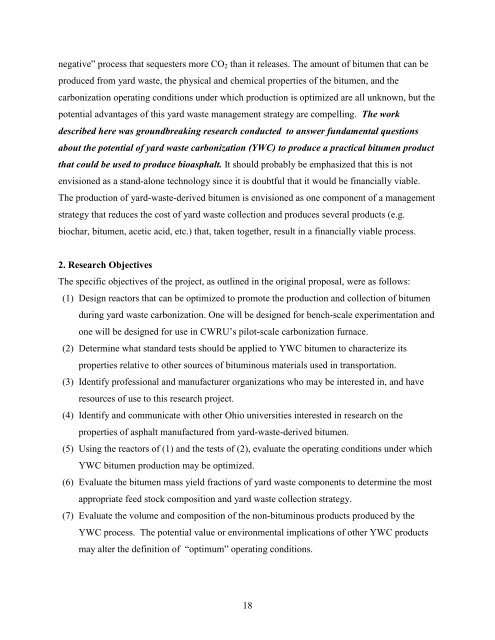Final Report - Ohio Department of Transportation
Final Report - Ohio Department of Transportation
Final Report - Ohio Department of Transportation
You also want an ePaper? Increase the reach of your titles
YUMPU automatically turns print PDFs into web optimized ePapers that Google loves.
negative” process that sequesters more CO2 than it releases. The amount <strong>of</strong> bitumen that can be<br />
produced from yard waste, the physical and chemical properties <strong>of</strong> the bitumen, and the<br />
carbonization operating conditions under which production is optimized are all unknown, but the<br />
potential advantages <strong>of</strong> this yard waste management strategy are compelling. The work<br />
described here was groundbreaking research conducted to answer fundamental questions<br />
about the potential <strong>of</strong> yard waste carbonization (YWC) to produce a practical bitumen product<br />
that could be used to produce bioasphalt. It should probably be emphasized that this is not<br />
envisioned as a stand-alone technology since it is doubtful that it would be financially viable.<br />
The production <strong>of</strong> yard-waste-derived bitumen is envisioned as one component <strong>of</strong> a management<br />
strategy that reduces the cost <strong>of</strong> yard waste collection and produces several products (e.g.<br />
biochar, bitumen, acetic acid, etc.) that, taken together, result in a financially viable process.<br />
2. Research Objectives<br />
The specific objectives <strong>of</strong> the project, as outlined in the original proposal, were as follows:<br />
(1) Design reactors that can be optimized to promote the production and collection <strong>of</strong> bitumen<br />
during yard waste carbonization. One will be designed for bench-scale experimentation and<br />
one will be designed for use in CWRU’s pilot-scale carbonization furnace.<br />
(2) Determine what standard tests should be applied to YWC bitumen to characterize its<br />
properties relative to other sources <strong>of</strong> bituminous materials used in transportation.<br />
(3) Identify pr<strong>of</strong>essional and manufacturer organizations who may be interested in, and have<br />
resources <strong>of</strong> use to this research project.<br />
(4) Identify and communicate with other <strong>Ohio</strong> universities interested in research on the<br />
properties <strong>of</strong> asphalt manufactured from yard-waste-derived bitumen.<br />
(5) Using the reactors <strong>of</strong> (1) and the tests <strong>of</strong> (2), evaluate the operating conditions under which<br />
YWC bitumen production may be optimized.<br />
(6) Evaluate the bitumen mass yield fractions <strong>of</strong> yard waste components to determine the most<br />
appropriate feed stock composition and yard waste collection strategy.<br />
(7) Evaluate the volume and composition <strong>of</strong> the non-bituminous products produced by the<br />
YWC process. The potential value or environmental implications <strong>of</strong> other YWC products<br />
may alter the definition <strong>of</strong> “optimum” operating conditions.<br />
18
















